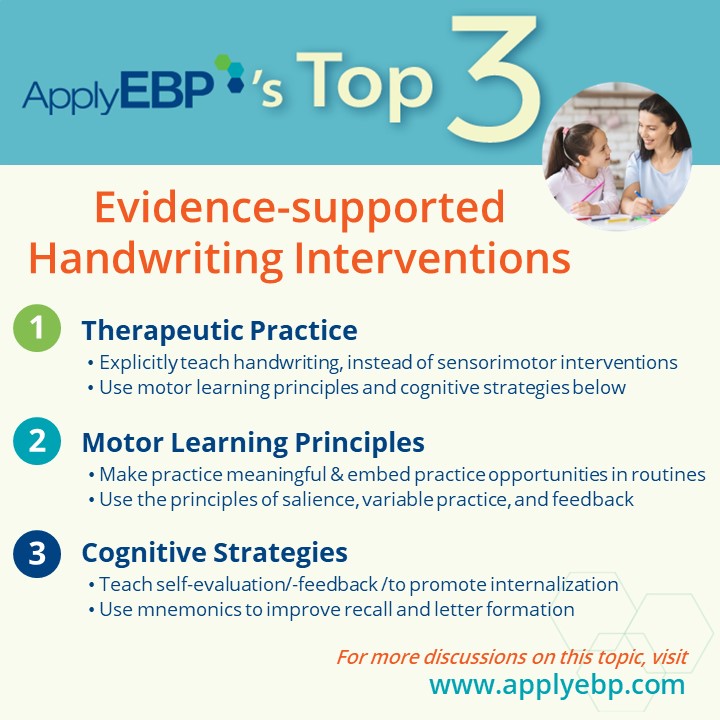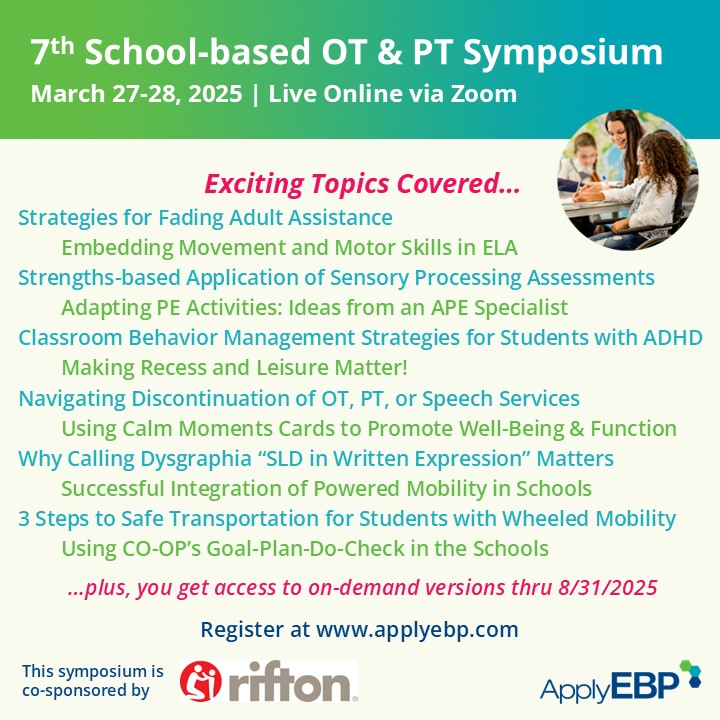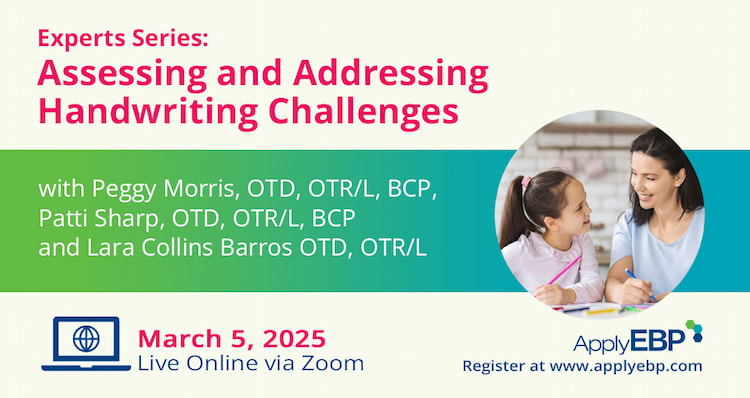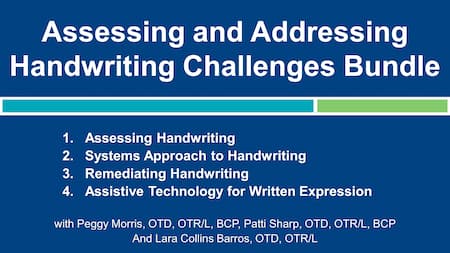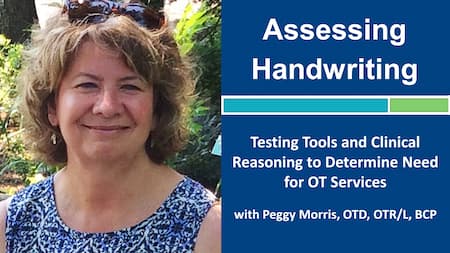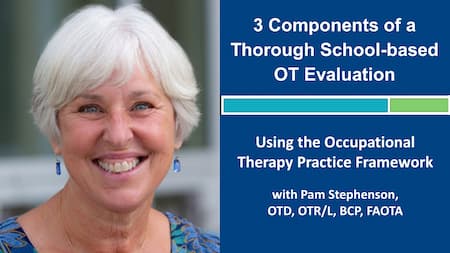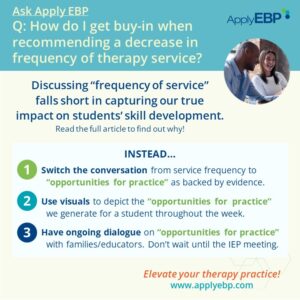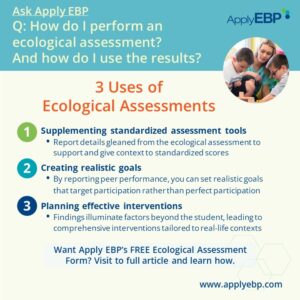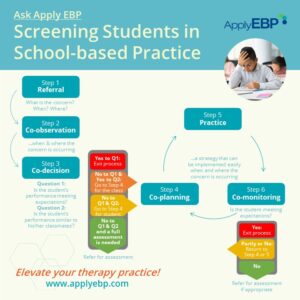Ask Apply EBP
Top 3 Effective Handwriting Interventions
Q: What are the best interventions for…Handwriting?
We are often asked about the best interventions for particular tasks. One of the most commonly asked is…for handwriting. Great news! Lots of research, including systematic reviews and randomized controlled trials (RCTs), have shown what interventions work, and what do not. Here are our Top 3 intervention strategies that work:
1. Therapeutic Practice
For improving handwriting legibility, the therapeutic practice of handwriting has been shown to be superior to sensorimotor interventions. Going further, the study by Denton et al (2006) found that those who were pulled out from class to receive sensorimotor interventions showed a decrease in their handwriting legibility, while a group that received no intervention (i.e., the students stayed in the classroom) maintained their handwriting legibility.
Therapeutic practice of handwriting includes the explicit teaching of handwriting, using motor learning principles and cognitive strategies, together with parental interventions for more practice at home.
This does not mean that OT practitioners should become handwriting teachers. Like everything else that students learn in school, it is best if handwriting is part of the students’ schooling. OT practitioners can recommend and support an off-the-shelf handwriting curriculum (e.g., Size Matters, Handwriting Without Tears) that can be delivered by teachers for the whole class.
OT practitioners can then focus their time and energy on assisting those students who continue to have handwriting challenges via an individualized therapeutic practice that incorporates motor learning principles and cognitive strategies discussed in #2 and #3 below.
In case you were curious, sensorimotor strategies in the various studies, included the remediation of visual perception (VP), visual motor integration (VMI), in-hand manipulation, and proprioceptive exercises. For example, visual closure, visual memory, figure-ground and spatial relationships worksheets, word find exercises, parquetry blocks, tangrams, drawing shapes on sand, cutting, pasting, tracing, origami, weight-bearing activities, scooter board, picking up objects with chopsticks, stereognosis activities, playing with marbles, mazes, dot-to-dot pictures, picking up coins, playing with shaving cream, and finishing patterns.
You might be thinking, is it ok if I mix sensorimotor strategies as a warm-up followed by therapeutic practice? Howe et al (2013) did just that and found that those who did handwriting practice only “produced handwriting scores that were significantly better in legibility than the students exposed to visual–perceptual–motor activities” for part of the therapy session.
2. Motor Learning Principles
Motor learning principles are principles that have been shown by research to promote the learning of motor skills. Here are some of these principles that you can incorporate right away, and examples of how they were done in various handwriting studies:
-
-
- Intense practice
- During a handwriting practice session, think about how you can maximize the amount of handwriting practice:
- Focus on handwriting activities during the whole session so that they can get as much practice as possible.
- Do not add activities that have nothing to do with letter formation (such as the sensorimotor activities listed in #1 above). If you are worried that this will make the session boring, see Salience strategies below.
- Think of multiple opportunities for practice, in and out of the handwriting practice sessions: You can do this by:
- For more practice opportunities in school, increase practice by:
- Embedding your services so you are seeing real-world factors impacting the child’s handwriting, and you are modeling to the teacher strategies that help improve the child’s handwriting.
- Embedding handwriting practice with a handwriting program for the whole class so that there is consistency in handwriting instruction in class.
- Collaborating and sharing information with the teacher. You can also align the teaching of the letters to what is used in the classroom, and use similar writing materials that are available in class.
- For more practice opportunities at home, instruct parents so they can support handwriting for completing homework, writing lists (e.g., grocery), writing recipes, or other opportunities for practice.
- For more practice opportunities in school, increase practice by:
- Spelling and correcting spelling errors can slow down writing practice. So decide whether you want to teach spelling during the session, or to focus on the writing for more handwriting practice, despite incorrect spellings.
- During a handwriting practice session, think about how you can maximize the amount of handwriting practice:
- Instruction and Modeling
- Explicit instruction on various aspects of handwriting, such as paper orientation (e.g., top line, middle line, bottom line, etc.), letter formation, spacing, etc.
- Demonstrate letter formation
- You can group letters for practice, for example, by similarity of formation or similarity of sizing
- Instruction can be provided individually, in groups, or for the whole class.
- Salience
- Incorporate meaningful activities, such as completion of homework or class work, writing thank you notes, creating invitations, etc.
- If you want to include games, select games that utilize handwriting, such as Hangman, Mad Libs, Scattergories, etc.
- Allow the child to use self-selected materials (e.g., colored pens, paper, etc.).
- Variable practice
- Practice different writing forms in a session, such as copying, dictation, and free writing.
- Practice multiple letters on the same session. Howe et al (2013), for example, taught 2 letters for every session.
- The salience strategies above (e.g., homework, recipe, hangman) also makes practice variable since the child needs to write different letters in the same session.
- For more variability change up materials in the same session, such as pen, pencil, marker, etc.
- Feedback
- Provide feedback on various aspects of their handwriting at random times during the session.
- Use the cognitive strategies in #3 below for promoting a student’s self-feedback.
- Intense practice
-
3. Cognitive Strategies
Cognitive strategies can be used during the writing session. Here are some examples from the research studies cited in this article:
-
-
- Use self-evaluation/self-feedback to promote internalization and recall. Some strategies can be:
- Ask them to encircle the 3 most legible words in their writing
- Ask them to identify their best handwriting during the session
- Ask them to explain how the best handwriting or more legible words are similar or different from their other writing samples, or from the copying sample.
- Ask them to identify letters that were incorrectly formed, and how they can improve the formation of the letter.
- Share written work with peers. Ask them to evaluate and provide feedback on each others’ work in the same manner as above.
- After learning to write a letter or a word, ask them to teach you how to write that letter or word
- Use mnemonics to improve recall and memorization of letter formation
- Use self-evaluation/self-feedback to promote internalization and recall. Some strategies can be:
-
Better yet, use the CO-OP Approach to involve the child in creating a plan on how to form letters in a manner that is meaningful to them (i.e., using their own plan; using their own mnemonics), and how to evaluate their own work. To learn more about CO-OP:
-
-
- Read Lara Barros’ free article: Applying CO-OP Principles in School-based Practice
- Take CO-OP Instructor Patti Sharp’s Remediating Handwriting on-demand webinar to learn some CO-OP principles that apply to handwriting
-
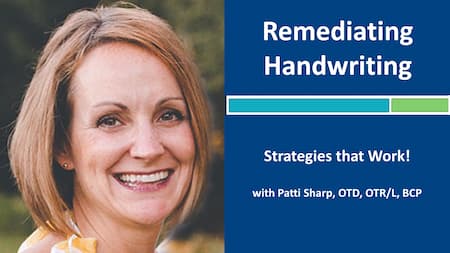
Perhaps you have more questions about handwriting, such as whether to work on grasp, tracing, or when to introduce assistive technology? Attend the Expert Series’ Assessing and Addressing Handwriting Challenges
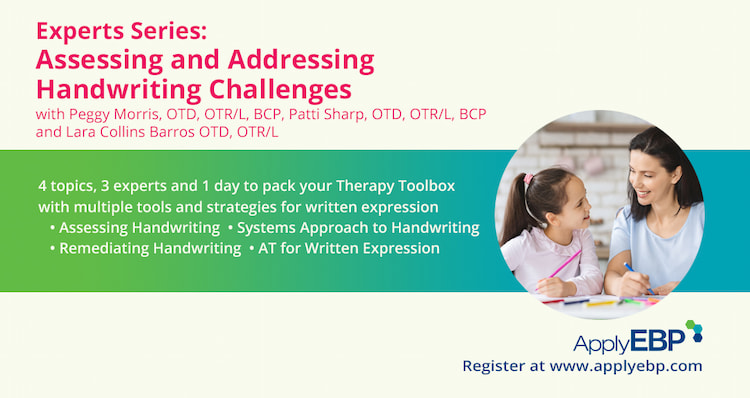
For more about school-based practice…
Or take these on-demand webinars:
References
Denton, P. L., Cope, S., & Moser, C. (2006). The effects of sensorimotor-based intervention versus therapeutic practice on improving handwriting performance in 6-to 11-year-old children. The American Journal of Occupational Therapy, 60(1), 16-27.
Fancher, L. A., Priestley-Hopkins, D. A., & Jeffries, L. M. (2018). Handwriting acquisition and intervention: A systematic review. Journal of Occupational Therapy, Schools, & Early Intervention, 11(4), 454-473.
Grajo, L. C., Candler, C., & Sarafian, A. (2020). Interventions within the scope of occupational therapy to improve children’s academic participation: A systematic review. The American Journal of Occupational Therapy, 74(2), 7402180030p1-7402180030p32.
Howe, T. H., Roston, K. L., Sheu, C. F., & Hinojosa, J. (2013). Assessing handwriting intervention effectiveness in elementary school students: A two-group controlled study. The American Journal of Occupational Therapy, 67(1), 19-26.
Weintraub, N., Yinon, M., Hirsch, I. B. E., & Parush, S. (2009). Effectiveness of sensorimotor and task-oriented handwriting intervention in elementary school-aged students with handwriting difficulties. OTJR: Occupation, Participation and Health, 29(3), 125-134.
Find More Answers to Your Questions in Our...
Featured School
Symposium
Featured Live
Workshop
Featured On-Demand
Webinar
3 Components of a Thorough School-based OT Evaluation
Featured Webinar
Bundle
Assessing and Addressing Handwriting Challenges Bundle
Have a question?
Submit here…
*Clicking submit will send your question directly to our email inbox. Your name and email will let us know that your submission is real (not spam). We will not include these in our posts, unless you tell us to include your name. Please read our privacy policy here.
All infographics and videos on www.applyebp.com are intellectual properties of Apply EBP, LLC
You may use the infographics and videos for free for any non-commercial, educational purposes. Please cite the source as “Apply EBP, LLC” and a link to the source article. If you plan to use any infographic or video for commercial purposes (i.e., for profit), please email Carlo@applyebp.com to obtain a written permission. Permission can be granted on a case-by-case basis.

